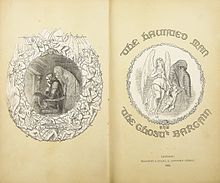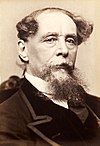The Haunted Man and the Ghost's Bargain
 Frontispiece of first edition, 1848 | |
| Author | Charles Dickens |
|---|---|
| Original title | The Haunted Man and the Ghost’s Bargain, A Fancy for Christmas-Time |
| Illustrator | Sir John Tenniel Frank Stone William Clarkson Stanfield John Leech |
| Country | England |
| Language | English |
| Genre | Novella |
| Publisher | Bradbury & Evans |
Publication date | 19 December 1848 |
| Media type | Print (Hardcover & Paperback) |
| Pages | 188 pp |
| Preceded by | Dombey and Son |
| Followed by | David Copperfield |
The Haunted Man and the Ghost's Bargain, A Fancy for Christmas-Time (better known as The Haunted Man and the Ghost's Bargain or simply as The Haunted Man) is a novella by Charles Dickens first published in 1848. It is the fifth and last of Dickens's Christmas novellas. The story is more about the spirit of the holidays than about the holidays themselves, harking back to the first in the series, A Christmas Carol. The tale centres on a Professor Redlaw and those close to him.
Plot summary

Redlaw is a teacher of chemistry who often broods over wrongs done him and grief from his past.
He is haunted by a spirit, who is not so much a ghost as Redlaw's phantom twin and is "an awful likeness of himself...with his features, and his bright eyes, and his grizzled hair, and dressed in the gloomy shadow of his dress..." This spectre appears and proposes to Redlaw that he can allow him to "forget the sorrow, wrong, and trouble you have known...to cancel their remembrance..." Redlaw is hesitant at first, but finally agrees. However, before the spirit vanishes it imposes an additional consequence: "The gift that I have given you, you shall give again, go where you will."
Besides Redlaw, the book is populated with the people of Redlaw's life. Most of them are semi-comical characters such as the Tetterby family who rent a room to one of Redlaw's students and the Swidger family who are Redlaw's servants. Milly Swidger, William Swidger's wife, is another of the absolutely good women who frequent many of Dickens's stories.
As a consequence of the ghost's intervention, Redlaw is without memories of the painful incidents from his past. He experiences a universal anger that he cannot explain. His bitterness spreads to the Swidgers, the Tetterbys and his student. All become as wrathful as Redlaw himself. The only one who is able to avoid the bitterness is Milly.
The narrative climaxes when Milly presents the moral of the tale: "It is important to remember past sorrows and wrongs so that you can then forgive those responsible and, in doing so, unburden your soul and mature as a human being." With this realization, the novel concludes with everyone back to normal and Redlaw, like Ebenezer Scrooge, a changed, more loving man. Now a whole person, Redlaw learns to be humble at Christmas.
Performances
In what would be the first public performance of the technique known as Pepper's ghost, John Henry Pepper staged a Christmas Eve production of play in 1862 at the Royal Polytechnic Institution (currently known as the University of Westminster) in 309 Regent Street. It was very well received, if only for the new apparatus's ability to project a ghost so as to look as though it is interacting with those on stage.[1]
References
- ^ Secord, J. A. (6 September 2002). "Quick and Magical Shaper of Science". Science. American Association for the Advancement of Science. Retrieved 15 August 2012.
External links
Online editions
- The Haunted Man and the Ghost’s Bargain at Internet Archive.
- The Haunted Man and the Ghost’s Bargain at Project Gutenberg
- The Haunted Man and the Ghost's Bargain, a free and easy to read HTML version.
 The Haunted Man and the Ghost's Bargain public domain audiobook at LibriVox
The Haunted Man and the Ghost's Bargain public domain audiobook at LibriVox

